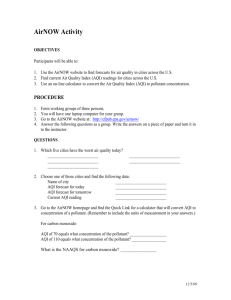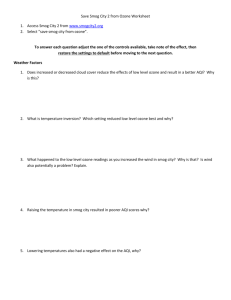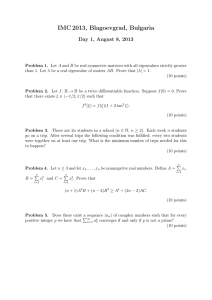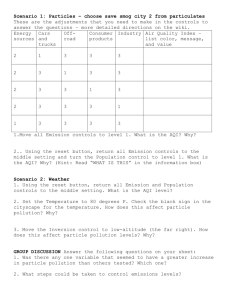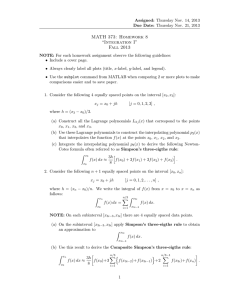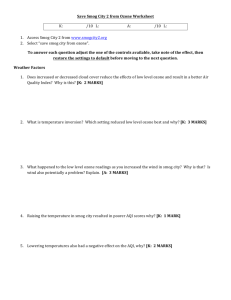Assignment 2 Solution
advertisement
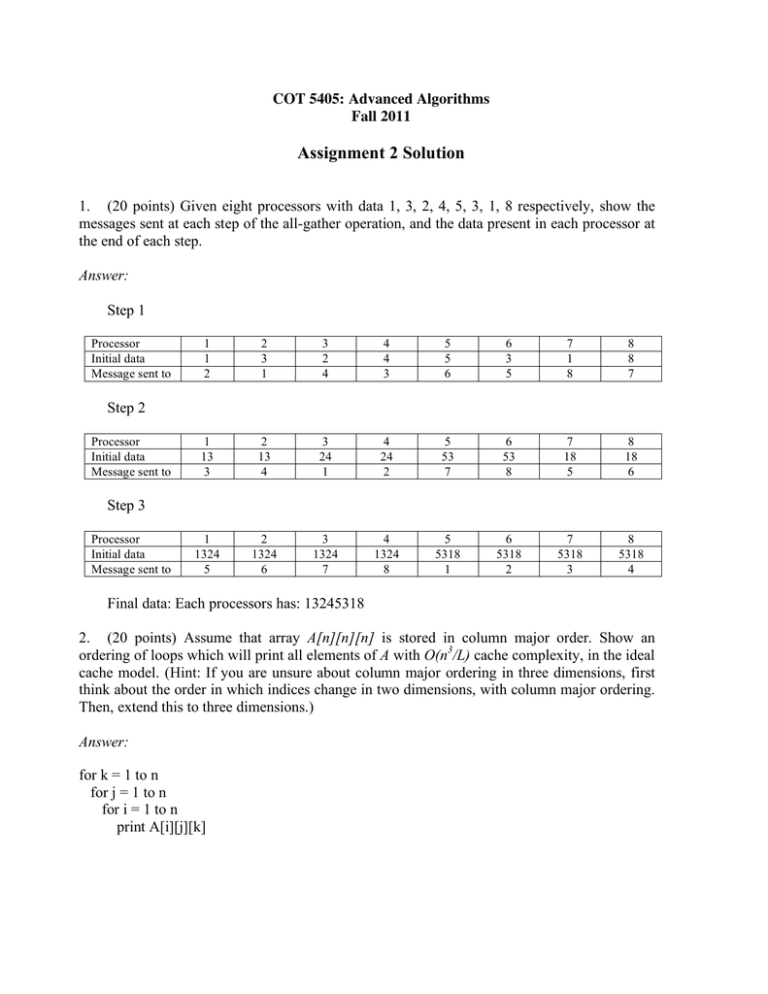
COT 5405: Advanced Algorithms
Fall 2011
Assignment 2 Solution
1. (20 points) Given eight processors with data 1, 3, 2, 4, 5, 3, 1, 8 respectively, show the
messages sent at each step of the all-gather operation, and the data present in each processor at
the end of each step.
Answer:
Step 1
Processor
Initial data
Message sent to
1
1
2
2
3
1
3
2
4
4
4
3
5
5
6
6
3
5
7
1
8
8
8
7
1
13
3
2
13
4
3
24
1
4
24
2
5
53
7
6
53
8
7
18
5
8
18
6
1
1324
5
2
1324
6
3
1324
7
4
1324
8
5
5318
1
6
5318
2
7
5318
3
8
5318
4
Step 2
Processor
Initial data
Message sent to
Step 3
Processor
Initial data
Message sent to
Final data: Each processors has: 13245318
2. (20 points) Assume that array A[n][n][n] is stored in column major order. Show an
ordering of loops which will print all elements of A with O(n3/L) cache complexity, in the ideal
cache model. (Hint: If you are unsure about column major ordering in three dimensions, first
think about the order in which indices change in two dimensions, with column major ordering.
Then, extend this to three dimensions.)
Answer:
for k = 1 to n
for j = 1 to n
for i = 1 to n
print A[i][j][k]
3. (20 points) Consider the following linear recurrence: xi+3 = ai+3 xi + bi+3 xi+1 + ci+3 xi+2,
where x0, x1, and x2 are given. Formulate the solution of this recurrence as a prefix
computation and give the parallel time complexity, speedup, and efficiency if parallel prefix is
used to solve it.
Answer:
x3i+3 = a3i+3 x3i + b3i+3 x3i+1 + c3i+3 x3i+2
x3i+4 = a3i+4 x3i+1 + b3i+4 x3i+2 + c3i+4 x3i+3
x3i+5 = a3i+5 x3i+2 + b3i+5 x3i+3 + c3i+5 x3i+4
x3i+4 = a3i+4 x3i+1 + b3i+4 x3i+2 + c3i+4 (a3i+3 x3i + b3i+3 x3i+1 + c3i+3 x3i+2)
= c3i+4 a3i+3 x3i + (a3i+4 + c3i+4 b3i+3) x3i+1 + (b3i+4 + c3i+4 c3i+3) x3i+2
x3i+5 = a3i+5 x3i+2 + b3i+5 (a3i+3 x3i + b3i+3 x3i+1 + c3i+3 x3i+2) + c3i+5 [c3i+4 a3i+3 x3i + (a3i+4 +
c3i+4 b3i+3) x3i+1 + (b3i+4 + c3i+4 c3i+3) x3i+2]
= (b3i+5 a3i+3 + c3i+5 c3i+4 a3i+3) x3i + (b3i+5 b3i+3 + c3i+5[a3i+4 + c3i+4 b3i+3]]) x3i+1 + (a3i+5
+ b3i+5 c3i+3 + c3i+5[b3i+4 + c3i+4 c3i+3]) x3i+2
From the above, we can write the recurrence as
X0 = [x0, x1, x2]T, Xi+1 = Ai Xi, where Xi is defined as [x3i, x3i+1, x3i+2]T and
! a3i+3
b3i+3
c3i+3
"
Ai =# c3i+4 a3i+3
a3i+4 + c3i+4 b3i+3
b3i+4 + c3i+4 c3i+3
#
$ b3i+5a3i+3+c3i+5c3i+4 a3i+3 b3i+5b3i+3+c3i+5[a3i+4 +c3i+4 b3i+3]] a3i+5 +b3i+5c3i+3+c3i+5[b3i+4+c3i+4c3i+3] %
The recurrence above is the desired prefix computation. Note that Xi needs to be computed
only up to i = n/3 – 1.
The sequential computation takes around 2n arithmetic operations. The parallel
computation requires log n steps with each step involving around 45 arithmetic operations
(multiplication of 3x3 matrices) plus log n communications, for a time complexity of
O([1+ts+tb] log n).
Speedup = 2n/[(45+ts+tb) log n]
Efficiency = 2n/([(45+ts+tb) log n] n/3) = 6/[(45+ts+tb) log n]
4. (20 points) Consider a strict quadratic program with 0-1 constraints on the variables.
Convert it to an equivalent strict quadratic program without any 0-1 constraints, and prove that
the two are equivalent.
Answer:
0-1 strict quadratic program: min &i,j aij xi xj
Subject to:
&i,j ckij xi xj ! bk, for 1 ! k! m
xi ' {0, 1}
Strict quadratic program: min &i,j aij (vi-wi) (vj-wj)/4
Subject to:
&i,j ckij (vi-wi)(vj-wj)/4 ! bk, for 1 ! k! m
vi2 = wi2 = 1
(vi-wi)(vj-wj) " 0 for all i,j, if aij # 0 or ckij # 0 for any k
They are equivalent for the following reason.
Consider a feasible solution xi for the first problem. If xi = 0 then choose vi = wi = 1
otherwise choose vi = 1 and wi = -1, yielding a feasible solution for the second problem
with the same objective function value.
Now, consider a feasible solution vi = wi for the second problem. If vi - wi = 0 then
choose xi = 0 otherwise choose xi = 1, yielding a feasible solution for the first problem
with the same objective function value.
Consequently, the two problems are equivalent.
5. (20 points) Formulate the vertex cover problem with weights on the vertices as a strict
quadratic program (without any integer constraints) and show its relaxation to a vector
program. Write the vector program as an equivalent semi-definite program.
Answer:
Vertex cover: min &i, xi
Subject to:
xi+xj " 1, for each edge {i,j}
xi ' {0, 1}
This is equivalent to: min &i, xi2
Subject to:
xi2+xj2 " 1, for each edge {i,j}
xi ' {0, 1}
The above problem can be reformulated as a strict quadratic program using the solution
of problem 4 as follows: min &i, (vi-wi )2
Subject to:
(vi-wi )2+(vj-wj )2 " 1, for each edge {i,j}
vi2 = wi2 = 1
(vi-wi )2 " 0
This is transformed to the following vector program, where vi, wi are vectors:
min &i, (vi-wi )•(vi-wi )
Subject to:
(vi-wi )•(vi-wi ) + (vj-wj )•(vj-wj )" 1, for each edge {i,j}
vi•vi = wi•wi = 1
(vi-wi )•(vi-wi ) " 0
An equivalent semi-definite program is given below using the standard transformation.
Note that v and w will become part of the same matrix. We will number the components
of w after those of v. So, w1 will become variable n+1, w2 will become variable n+2, etc.
min &i, yii + yn+i,n+i - 2 yi,n+i
Subject to:
yii + yn+i,n+i - 2 yi,n+i + yjj + yn+j,n+j - 2 yj,n+j " 1, for each edge {i,j}
yii = 1
yii + yn+i,n+i - 2 yi,n+i " 0
Y is symmetric positive semi-definite
